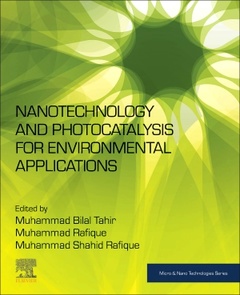Description
Nanotechnology and Photocatalysis for Environmental Applications
Micro and Nano Technologies Series
Coordinators: Tahir Muhammad Bilal, Rafique Muhammad, Rafique Muhammad Shahid
Language: English
Subject for Nanotechnology and Photocatalysis for Environmental...:
Keywords
Nanotechnology; Nanomaterials; Photocatalysis; Nanosynthesis; Nanocomposites
244 p. · 19x23.3 cm · Paperback
Description
/li>Contents
/li>Biography
/li>Comment
/li>
Nanotechnology and Photocatalysis for Environmental Applications focuses on nanostructured control, synthesis methods, activity enhancement strategies, environmental applications, and perspectives of semiconductor-based nanostructures. The book offers future guidelines for designing new semiconductor-based photocatalysts, with low cost and high efficiency, for a range of products aimed at environmental protection. The book covers the fundamentals of nanotechnology, the synthesis of nanotechnology, and the use of metal oxide, metal sulfide, and carbon-based nanomaterials in photocatalysis. The book also discusses the major challenges of using photocatalytic nanomaterials on a broad scale.
The book then explores how photocatalytic nanomaterials and nanocomposites are being used for sustainable development applications, including environmental protection, pharmaceuticals, and air purification. The final chapter considers the recent advances in the field and outlines future perspectives on the technology. This is an important reference for materials scientists, chemical engineers, energy scientists, and anyone looking to understand more about the photocatalytic potential of nanomaterials, and their possible environmental applications.
1. History and Fundamentals of Nanoscience and Nanotechnology 2. Nanostructures and their classification by dimensionality 3. Synthesis Methods of Nanostructures 4. Photocatalysis fundamentals 5. Nanomaterials for Photocatalysis 6. Metal oxide and Metal Sulphide based Nanomaterials as a Photocatalyst 7. Carbonaceous Nanomaterials as a Photocatalyst 8. Photocatalytic Nanomaterials for degradation of organic pollutant and heavy metals 9. Photocatalytic Nanomaterials for Hydrogen evolution from splitting water 10. Photocatalytic Nanomaterials for CO2 photo-reduction and Disinfection of bacteria 11. Photocatalytic Nanomaterials for Treatment of Pharmaceuticals 12. Photocatalytic Nanomaterials for Air purification and Self-cleaning 13. Recent advances in the development of photocatalysis and future perspectives
Muhammad Rafique is Assistant Professor of Nanotechnology and Nanosciences, at the Department of Physics, University of Gujrat, Pakistan. His research focuses on the area of nanomaterials synthesis.
Muhammad Shahid Rafique is Professor and Director, at the Laser & Optronics Centre, University of Engineering and Technology, Lahore, Pakistan. His research focuses on the areas of nanomaterials and thin films.
- Explains why the properties of semiconductor-based nanomaterials make them particularly good for environmental applications
- Explores how photocatalytic nanomaterials and nanocomposites are being used for sustainable development applications, including environmental protection, pharmaceuticals, and air purification
- Discusses the major challenges of using photocatalytic nanomaterials on a broad scale




